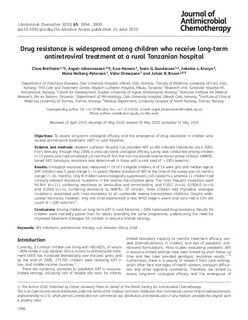| dc.contributor.author | Bratholm, Clara | |
| dc.contributor.author | Johannessen, Asgeir | |
| dc.contributor.author | Naman, Ezra | |
| dc.contributor.author | Gundersen, Svein Gunnar | |
| dc.contributor.author | Kivujo, Sokoine L. | |
| dc.contributor.author | Holberg-Petersen, Mona | |
| dc.contributor.author | Ormaasen, Vidar | |
| dc.contributor.author | Brun, Johan N. | |
| dc.date.accessioned | 2010-09-21T15:24:22Z | |
| dc.date.available | 2010-09-21T15:24:22Z | |
| dc.date.issued | 2010 | |
| dc.identifier.citation | Bratholm, C., Johannessen, A., Naman, E., Gundersen, S. G., Kivuyo, S. L., Holberg-Petersen, M., . . . Bruun, J. N. (2010). Drug resistance is widespread among children who receive long-term antiretroviral treatment at a rural Tanzanian hospital. Journal of Antimicrobial Chemotherapy, 65(9), 1996-2000. doi: 10.1093/jac/dkq234 | en_US |
| dc.identifier.issn | 0305-7453 | |
| dc.identifier.uri | http://hdl.handle.net/11250/135296 | |
| dc.description | Published version of an article from the journal: Journal of Antimicrobial Chemotherapy. Also available from the publisher: htttp://dx.doi.org/10.1093/jac/dkq234 | en_US |
| dc.description.abstract | Objectives: To assess long-term virological efficacy and the emergence of drug resistance in children who receive antiretroviral treatment (ART) in rural Tanzania. Patients and methods: Haydom Lutheran Hospital has provided ART to HIV-infected individuals since 2003. From February through May 2009, a cross-sectional virological efficacy survey was conducted among children (, 15 years) who had completed >= 6 months of first-line non-nucleoside reverse transcriptase inhibitor (NNRTI)-based ART. Genotypic resistance was determined in those with a viral load of >200 copies/mL. Results: Virological response was measured in 19 of 23 eligible children; 8 of 19 were girls and median age at ART initiation was 5 years (range 2-14 years). Median duration of ART at the time of the survey was 40 months (range 11-61 months). Only 8 children were virologically suppressed (<= 40 copies/mL), whereas 11 children had clinically relevant resistance mutations in the reverse transcriptase gene. The most frequent mutations were M184V (n=11), conferring resistance to lamivudine and emtricitabine, and Y181C (n=4), G190A/S (n=4) and K103N (n=4), conferring resistance to NNRTIs. Of concern, three children had thymidine analogue mutations, associated with cross-resistance to all nucleoside reverse transcriptase inhibitors. Despite widespread resistance, however, only one child experienced a new WHO stage 4 event and none had a CD4 cell count of <200 cells/mm(3). Conclusions: Among children on long-term ART in rural Tanzania, >50% harboured drug resistance. Results for children were markedly poorer than for adults attending the same programme, underscoring the need for improved treatment strategies for children in resource-limited settings. | en_US |
| dc.language.iso | eng | en_US |
| dc.publisher | Oxford University Press | en_US |
| dc.title | Drug resistance is widespread among children who receive long-term antiretroviral treatment at a rural Tanzanian hospita | en_US |
| dc.type | Journal article | en_US |
| dc.type | Peer reviewed | en_US |
| dc.subject.nsi | VDP::Medical disciplines: 700::Clinical medical disciplines: 750::Communicable diseases: 776 | en_US |
| dc.source.pagenumber | 1996-2000 | en_US |
